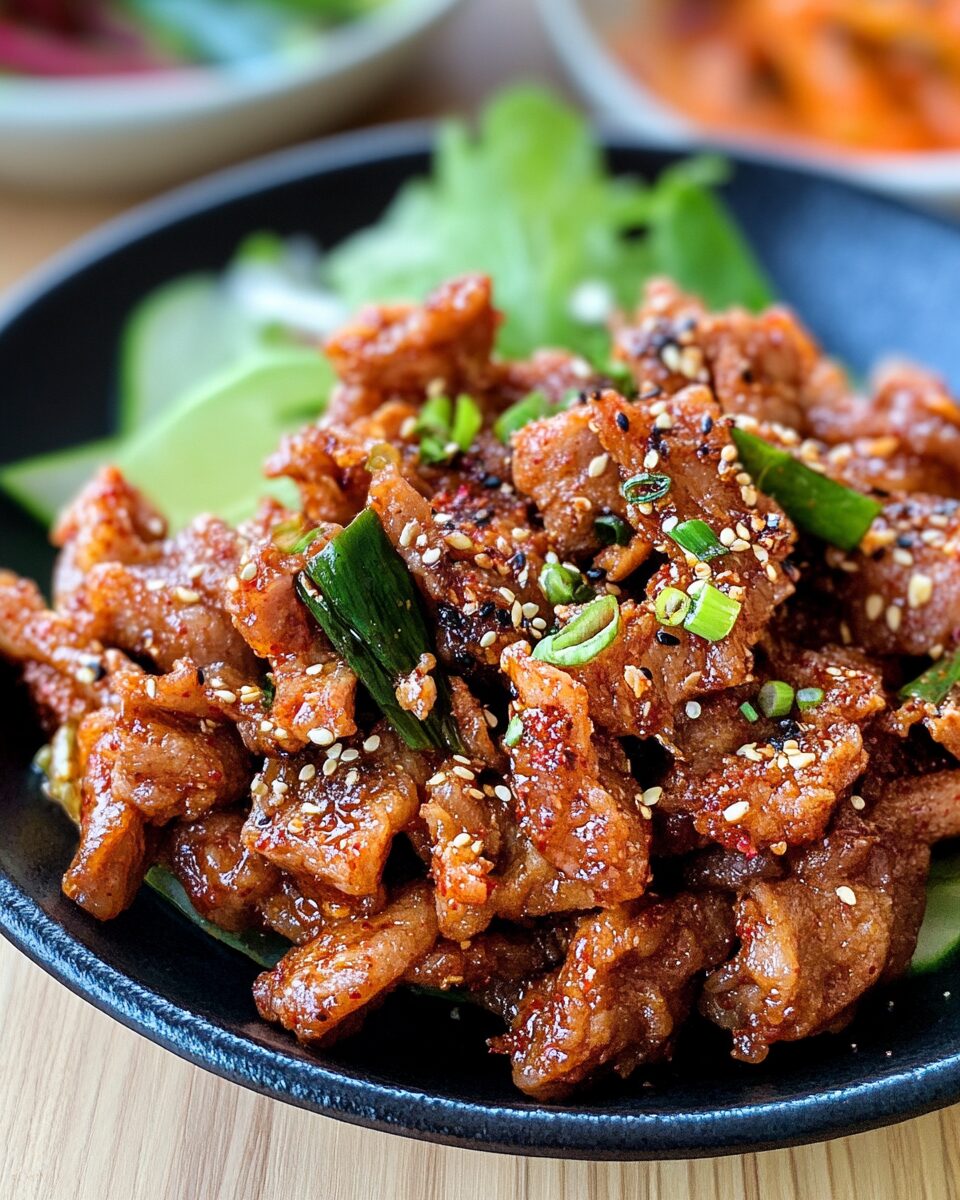The bold and savory Spicy Korean Pork Bulgogi (Jeyuk Bokkeum) delivers a rich punch of gochujang heat, mellowed by sweet apple and fragrant aromatics. Whether grilled or stir-fried, the pork turns beautifully caramelized, each bite full of umami and heat that pairs irresistibly with rice or wrapped in crisp lettuce leaves.
This dish is a staple in Korean cuisine, popular both for backyard grilling and cozy home dinners. It’s quick to prepare, easy to love, and endlessly customizable — toss in bell peppers, mushrooms, or chili for added crunch and kick. Perfect for busy nights or weekend feasts alike.
Full recipe:
Ingredients:
-
2 pounds thinly sliced pork shoulder or butt (or a mix with pork belly)
-
1/2 medium onion, thinly sliced
-
3 scallions, cut into 2-inch pieces
For the Marinade:
-
6 tablespoons gochujang (Korean red chili paste)
-
1 to 2 tablespoons gochugaru (Korean red chili flakes)
-
3 tablespoons soy sauce
-
3 tablespoons cooking rice wine (Mirim or Mirin)
-
2 tablespoons sugar (or brown sugar)
-
1 tablespoon honey (or extra sugar)
-
2 tablespoons sesame oil
-
2 tablespoons minced garlic
-
1 tablespoon grated ginger
-
3–4 tablespoons grated apple (or 2 tablespoons Korean plum syrup)
Directions:
-
In a large mixing bowl, combine all the marinade ingredients and mix well.
-
Add the thinly sliced pork to the bowl and mix thoroughly to ensure all pieces are evenly coated.
-
Add the sliced onion and scallions to the bowl and toss to combine.
-
Cover and let marinate for 30 minutes at room temperature or up to 4 hours in the fridge.
-
Heat a skillet over medium-high heat.
-
Add half the pork mixture and cook, stirring occasionally, until the pork is cooked through and slightly caramelized (about 6–8 minutes). Repeat with the remaining batch.
-
Serve hot with steamed rice or wrapped in lettuce leaves with ssamjang sauce.
Prep Time: 15 minutes | Cooking Time: 15 minutes | Total Time: 30 minutes
Kcal: ~410 kcal per serving | Servings: 4 servings
A Brief History and Cultural Significance
Korean BBQ, or gogi-gui, is a time-honored tradition rooted deeply in the Korean dining experience. While beef dishes like bulgogi and galbi often get the spotlight, pork dishes like Jeyuk Bokkeum are equally central, especially in home cooking. In fact, due to the relative affordability of pork in Korea, spicy pork bulgogi has long been a go-to comfort food enjoyed by families, students, and workers.
Jeyuk Bokkeum is often associated with hearty, casual meals. Unlike beef bulgogi, which might be reserved for special occasions, this spicy pork version is everyday food — humble, flavorful, and deeply satisfying. It’s commonly found in Korean diners (called bunsikjip) and featured in lunchboxes (dosirak) or quick weekday dinners.
The Magic of the Marinade
At the heart of Jeyuk Bokkeum is its complex marinade. Korean cuisine excels at balancing flavors, and this dish is no exception. The marinade achieves a balance between heat, sweetness, acidity, and umami, largely thanks to its blend of fermented and fresh ingredients.
-
Gochujang provides a spicy kick, but it also adds umami depth and a slight sweetness due to its fermented nature.
-
Gochugaru, the ground chili flakes, gives the dish its vivid red hue and customizable spiciness.
-
Garlic and ginger cut through the richness of the pork, offering pungency and freshness.
-
Grated apple or Korean plum syrup introduces a subtle acidity and fruitiness, enhancing the overall complexity of the dish.
-
Sesame oil and soy sauce contribute nutty richness and saltiness, completing the flavor profile.
One of the best things about this marinade is its adaptability. The heat level can be toned down or turned up, making it suitable for different preferences. Some households even add a spoon of doenjang (fermented soybean paste) or fish sauce for a more layered, umami-forward twist.
Choosing the Right Cut of Pork
The cut of pork is crucial in getting the right texture and flavor in this dish. Traditional recipes recommend pork shoulder (butt) or pork belly — both are fatty, which helps balance the spicy sauce and keeps the meat tender and juicy during cooking. Fatty cuts caramelize beautifully in the pan, creating crispy edges and a satisfying chew.
Lean cuts like tenderloin can be used for a lighter variation, but they tend to dry out quicker and miss some of the lusciousness that pork shoulder or belly brings. To make slicing easier, especially for home cooks, it’s often recommended to partially freeze the meat for about 30 minutes beforehand.
Pan-Fried vs. Grilled: Different Cooking Methods
Jeyuk Bokkeum is traditionally pan-fried, which makes it more accessible for home cooking. In fact, the word bokkeum means stir-fried, reflecting how most people in Korea prepare it — fast and fuss-free on the stovetop. Stir-frying also allows the sauce to cling to the meat, reducing into a rich, glossy coating.
However, this dish also transitions beautifully to the grill. When cooked over open flames, the sugars in the marinade caramelize and char, adding an extra layer of smokiness and complexity. This method is popular for Korean BBQ restaurants and outdoor gatherings.
Regardless of the method, it’s important to cook the pork in batches and avoid crowding the pan or grill — this helps achieve the golden sear and prevents steaming.
Perfect Pairings and Serving Suggestions
Jeyuk Bokkeum is incredibly versatile when it comes to serving options. It’s most commonly enjoyed with:
-
Steamed short-grain rice, the perfect foil to the spicy, saucy pork
-
Lettuce wraps (ssam), usually with green or red leaf lettuce and perilla leaves, allowing for fresh, crunchy bites
-
Ssamjang, a savory dipping sauce made from doenjang, gochujang, garlic, and sesame oil, often added to wraps for extra umami
-
Banchan, or Korean side dishes, such as kimchi, pickled radish, mung bean sprouts, or seasoned spinach
Another popular way to enjoy this dish is to include vegetables like onions, mushrooms, or bell peppers in the stir-fry. This not only stretches the meal but adds texture and flavor diversity.
For a more indulgent experience, some Koreans top their pork bulgogi with melted cheese or serve it over rice with a fried egg. These modern twists are especially popular in Korean street food stalls and fusion restaurants.
Tips for the Best Jeyuk Bokkeum
-
Don’t skip the marinating time: Even 30 minutes makes a huge difference, but for more depth, marinate it for up to 4 hours in the fridge.
-
Use a hot pan: Medium-high to high heat helps sear the pork quickly and develop caramelization without overcooking.
-
Add a splash of water or stock if needed: If the pan dries out too quickly during cooking, a little moisture can help prevent burning and keep the pork tender.
-
Balance your wrap: A little pork, a dab of ssamjang, and a leaf of perilla or lettuce create a perfectly balanced bite.
Why This Dish Is So Loved
The reason Jeyuk Bokkeum continues to win hearts across generations and cultures is simple: it’s comfort food with attitude. The boldness of the flavors, the satisfying richness of the pork, and the interactive experience of making wraps or building your plate make it both nostalgic and exciting.
It’s also easy to prepare, making it ideal for beginners and busy home cooks. The ingredients are increasingly available outside of Korea, thanks to the rise of Korean grocery stores and the global popularity of K-food. And because it works just as well on the stovetop as it does on a grill, it can be made year-round.
Conclusion
Jeyuk Bokkeum, or spicy pork bulgogi, is more than just a meal — it’s a celebration of Korean flavor philosophy. Balancing heat, sweetness, and umami, it highlights the core elements that make Korean food so universally appealing. Whether you’re preparing it for a weekday dinner, a gathering with friends, or simply to explore new culinary territories, this dish delivers bold satisfaction in every bite.
From its roots in Korean home kitchens to its growing fan base worldwide, this fiery pork stir-fry is a testament to the joy of bold, beautiful food. It brings warmth to the table, encourages shared eating, and makes spice lovers swoon — and that’s why it deserves a spot on every food blog and home menu.






